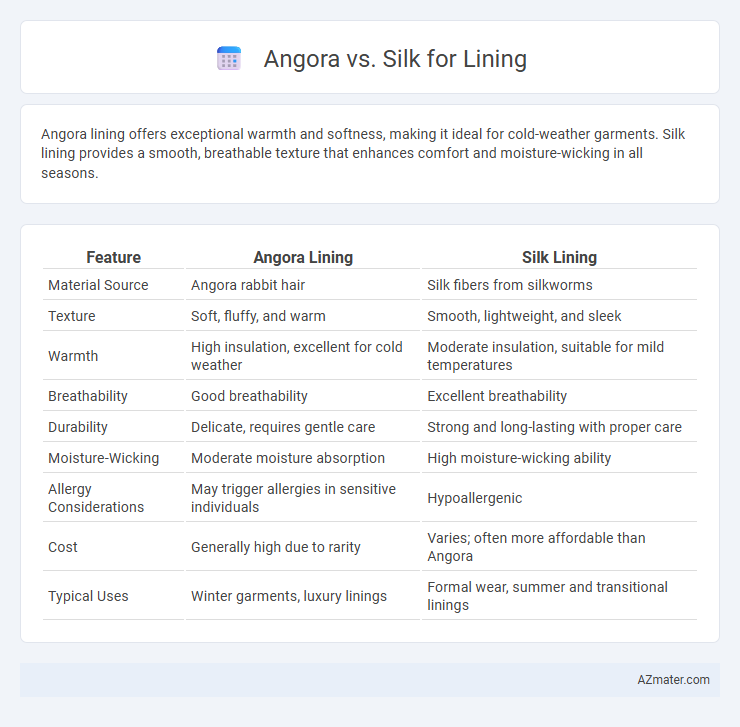Angora lining offers exceptional warmth and softness, making it ideal for cold-weather garments. Silk lining provides a smooth, breathable texture that enhances comfort and moisture-wicking in all seasons.
Table of Comparison
| Feature | Angora Lining | Silk Lining |
|---|---|---|
| Material Source | Angora rabbit hair | Silk fibers from silkworms |
| Texture | Soft, fluffy, and warm | Smooth, lightweight, and sleek |
| Warmth | High insulation, excellent for cold weather | Moderate insulation, suitable for mild temperatures |
| Breathability | Good breathability | Excellent breathability |
| Durability | Delicate, requires gentle care | Strong and long-lasting with proper care |
| Moisture-Wicking | Moderate moisture absorption | High moisture-wicking ability |
| Allergy Considerations | May trigger allergies in sensitive individuals | Hypoallergenic |
| Cost | Generally high due to rarity | Varies; often more affordable than Angora |
| Typical Uses | Winter garments, luxury linings | Formal wear, summer and transitional linings |
Introduction: Angora vs Silk for Lining
Angora and silk are both premium materials commonly used for lining garments due to their unique properties. Angora provides exceptional warmth and softness, making it ideal for winter clothing, while silk offers a smooth, lightweight, and breathable feel suitable for year-round comfort. Choosing between Angora and silk for lining depends on the desired thermal insulation and texture preferences of the garment.
Understanding Angora: Key Characteristics
Angora fibers, derived from Angora rabbits, are renowned for their exceptional softness, lightweight warmth, and remarkable insulation properties, making them ideal for luxury linings. Unlike silk, which offers a smooth, glossy finish and excellent breathability, Angora provides superior thermal regulation due to its hollow fiber structure that traps air efficiently. The delicate nature and natural elasticity of Angora require careful handling in lining applications to maintain durability and comfort.
What Makes Silk Unique for Lining?
Silk stands out for lining due to its natural hypoallergenic properties and exceptional breathability, providing comfort in both warm and cold weather. Its smooth texture reduces friction against skin and delicate fabrics, preventing irritation and damage. Unlike Angora, silk's moisture-wicking ability keeps the wearer dry by efficiently managing sweat and humidity.
Comfort Comparison: Angora and Silk
Angora provides exceptional warmth and softness due to its hollow fibers, making it ideal for insulation in lining materials, while silk offers a smooth, lightweight texture that excels in breathability and moisture-wicking abilities. Angora's natural elasticity enhances comfort by allowing better movement, whereas silk's hypoallergenic properties prevent irritation for sensitive skin. Both fibers deliver distinct comfort benefits, with angora favoring thermal retention and silk prioritizing a cool, dry feel.
Insulation and Warmth Features
Angora fibers provide exceptional insulation due to their hollow core, trapping heat effectively and offering superior warmth for lining materials. Silk, while smooth and breathable, has moderate thermal properties but excels in moisture-wicking and lightweight comfort. For enhanced insulation in cold conditions, Angora linings outperform Silk by retaining body heat more efficiently.
Durability and Longevity
Angora lining offers exceptional softness but tends to be less durable and more prone to wear compared to silk, which provides a smooth, resilient texture that withstands frequent use. Silk's natural strength and resistance to moisture contribute to its superior longevity, making it ideal for lining garments intended for extended wear. While Angora excels in warmth and comfort, silk excels in durability and lifespan, ensuring garments retain their quality over time.
Care and Maintenance Requirements
Angora lining requires gentle hand washing or dry cleaning to maintain its softness and prevent felting, with careful avoidance of heat and friction. Silk lining demands delicate care, typically needing dry cleaning, as exposure to water and harsh detergents can weaken fibers and cause color fading. Proper storage in a cool, dry place away from direct sunlight is crucial for both fabrics to preserve their luxurious texture and appearance.
Hypoallergenic Qualities: Which is Better?
Angora wool is naturally hypoallergenic due to its fine fibers and lack of lanolin, making it less likely to cause allergic reactions compared to traditional wool. Silk also exhibits hypoallergenic properties by resisting dust mites, mold, and mildew, which benefits sensitive skin. Between the two, silk lining is generally considered superior in hypoallergenic qualities because it effectively repels common allergens while providing a smooth texture ideal for sensitive individuals.
Cost and Accessibility
Angora lining typically costs more due to its rarity and the labor-intensive process of harvesting fine fibers from Angora rabbits, limiting its accessibility to niche markets and high-end fashion. Silk, while luxurious, is generally more affordable and widely available because of established global silk farming and production industries. The cost-effectiveness and broader accessibility of silk make it a popular choice for lining compared to the premium-priced and less accessible Angora option.
Final Verdict: Choosing the Best Lining
Angora provides superior warmth and softness, making it ideal for winter garments, while silk excels in breathability and moisture-wicking, offering comfort in varying temperatures. The best lining choice depends on climate and garment purpose; angora suits cold-weather luxury wear, whereas silk is perfect for lightweight, breathable clothing. Ultimately, prioritize angora for insulation and silk for elegant, temperature-regulating comfort.

Infographic: Angora vs Silk for Lining
 azmater.com
azmater.com